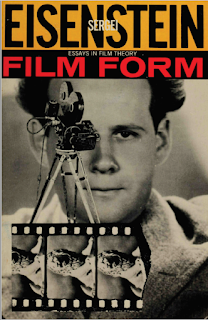"Film Form: Essays in Film Theory", Sergei Eisenstein
Sergei Eisenstein (1898-1948) was a Soviet filmmaker and film theorist. Known for his writings and practice of montage applied on his films, his filmic work shows an artist with total dominion of the plastic aspect of the cinema, causing a singular psychological effect through the collision of shots with carefully thought-out compositions. For the aesthetic avant-gardism of his works and contribution to the cinematographic technique, he is now regarded as one of the highest exponents in the history of cinema. He was a lover of Kabuki theater and classic literature, who influenced his way of thinking about films.
A student of architecture, he joined the Bolshevik revolution, collaborating as a painter, decorator and director in the Proletcult Theatre (1920-1924), the aesthetic instrument of the new regime. Then he made the highly acclaimed Strike (1925), Battleship Potemkin (1925) and October (1928), whose unusual camera angles and dynamic use of cinematography and montage made them much more than political propaganda. He undertook a trip to the United States, where he never made a complete film. He was not allowed to direct an adaptation of Theodore Dreiser's An American Tragedy reflecting on American social relations and how they can lead to crime, and he left unfinished ¡Que viva México! (1930), whose production was abandoned and suffered commercial modifications. In 1938 he returned to filmic activity in Soviet Union with Alexander Nevsky (1938). He ended his cinematographic career with two parts of an unfinished trilogy about Ivan, the Terrible (1944), until he died in 1948 of a heart attack.
Film Form: Essays in Film Theory, published in 1949, is the second of his compilation of his essays regarding the cinematic medium (the other being The Film Sense). In these, Eisenstein deepens his montage theories by using his own films, analyses the Kabuki theather and how it can be associated to cinematographic methods, discusses how he would have made the aborted adaptation of Dreiser's novel and demonstrates how Charles Dickens's writing influenced D. W. Griffith's visual style and narrative development.
Excerpts:
"The art of cinematography is not in selecting a fanciful framing, or in taking something from a surprising camera angle. The art is in every fragment of a film being an organic part of an organically conceived whole."
"The shot is by no means an element of montage.
The shot is a montage cell.
Just as cells in their division form a phenomenon of another order, the organism or embryo, so, on the other side of the dialectical leap from the shot, there is montage.
By what, then, is montage characterized and, consequently, its cell-the shot?
By collision. By the conflict of two pieces in opposition to each other. By conflict. By collision"
"In order to understand Griffith, one must visualize an America made up of more than visions of speeding automobiles, streamlined trains, racing ticker tape, inexorable conveyorbelts. One is obliged to comprehend this second side of America as well-America, the traditional, the patriarchal, the provincial. And then you will be considerably less astonished by this link between Griffith and Dickens. The threads of both these Americas are interwoven in the style and personality of Griffith-as in the most fantastic of his own parallel montage sequences."
Link to the complete book in PDF:
https://drive.google.com/file/d/1PjisWPJCdtC5LynWjhcmY_9xI_xVbowL/view?usp=sharing
Film Form: Essays in Film Theory, published in 1949, is the second of his compilation of his essays regarding the cinematic medium (the other being The Film Sense). In these, Eisenstein deepens his montage theories by using his own films, analyses the Kabuki theather and how it can be associated to cinematographic methods, discusses how he would have made the aborted adaptation of Dreiser's novel and demonstrates how Charles Dickens's writing influenced D. W. Griffith's visual style and narrative development.
Excerpts:
"The art of cinematography is not in selecting a fanciful framing, or in taking something from a surprising camera angle. The art is in every fragment of a film being an organic part of an organically conceived whole."
"The shot is by no means an element of montage.
The shot is a montage cell.
Just as cells in their division form a phenomenon of another order, the organism or embryo, so, on the other side of the dialectical leap from the shot, there is montage.
By what, then, is montage characterized and, consequently, its cell-the shot?
By collision. By the conflict of two pieces in opposition to each other. By conflict. By collision"
"In order to understand Griffith, one must visualize an America made up of more than visions of speeding automobiles, streamlined trains, racing ticker tape, inexorable conveyorbelts. One is obliged to comprehend this second side of America as well-America, the traditional, the patriarchal, the provincial. And then you will be considerably less astonished by this link between Griffith and Dickens. The threads of both these Americas are interwoven in the style and personality of Griffith-as in the most fantastic of his own parallel montage sequences."
Link to the complete book in PDF:
https://drive.google.com/file/d/1PjisWPJCdtC5LynWjhcmY_9xI_xVbowL/view?usp=sharing
 |
| Sergei Eisenstein |




Soap2day is a very good website to watch TV series and movies for free.
ReplyDeleteCollege student Noor wanted free Ligue 1 streams on her iPad without subscriptions. A friend pointed her to yacinedl.com's guide for ياسين tv للايفون. She used TutuApp to sideload the IPA, loves the minimal ads and adaptive quality up to 1080p, even on campus WiFi.
ReplyDelete